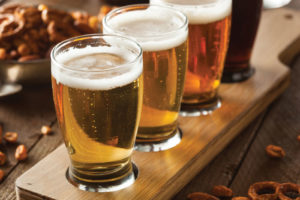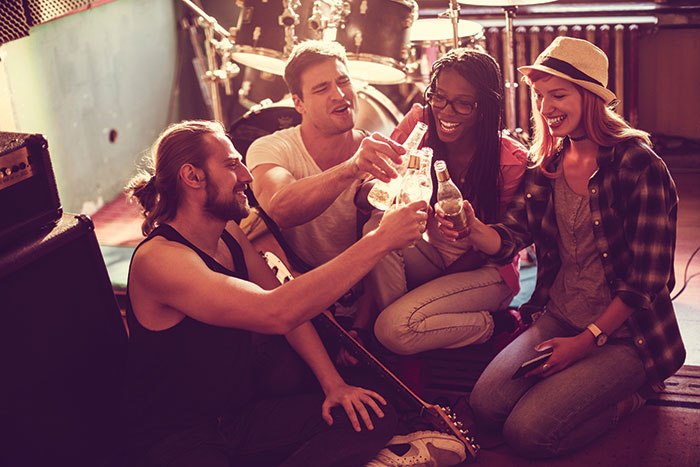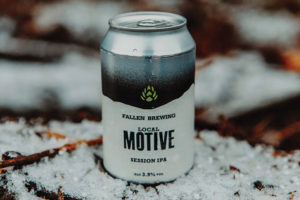Toby Hill looks at the result of the recent upheaval in the beer & cider category to find out what both new and older generations of drinkers want from their tipples.
Few categories have seen such upheaval in recent years as that of beer & cider. Various currents in consumer buying habits have ripped through the alcohol market, upending past certainties and forcing wholesalers to adjust both their core ranges and their speciality offerings. No longer can wholesalers stack up slabs of the most well-known brands and feel they’ve met their customers’ needs – tastes in world beer, craft beer, fruit ciders and real ale all have to be thoughtfully catered to.
“Wholesalers must not make the mistake of thinking that all previous lager drinkers will only want one style of beer,” says Paul Fallen, managing director of Fallen Brewing, whose business has caught the wave of many of these changes. “The market is becoming much more discerning than that. Drinkers want to try several different beer styles for different occasions, such as a lighter blond beer as an aperitif or a more flavourful amber beer with food.”
While navigating such rapid changes can seem daunting, it also provides plentiful opportunities for wholesalers to hone their range with greater precision, maximising both volume sales on core brands and margins on selected niche products.
Here, we take a look at the major trends that have been shaping the revolution in British boozing, and draw on supplier insight and market research to outline strategies for getting the most out of this crucial category.
Match the moment
As drinkers become more thoughtful in their choice of drink, wholesalers need to make sure they tailor their ranges to the seasons and events that are likely to prompt buying decisions.
“Wholesalers can boost their core range sales by making sure their products are visible at relevant moments and seasonal occasions,” says Peppi Cremona, sales director for off-trade wholesale and convenience at AB InBev. “That means pushing your core beer and cider ranges in the summer months, while bringing your lagers and ales to the fore during the darker, winter months.”
 According to analysis by Diageo, fruit cider is the fastest-growing segment in cider, experiencing double-digit growth. Diageo has responded accordingly, adding a third flavour to its fruity Smirnoff-branded venture into the cider market, with Mandarin & Pink Grapefruit having joined its siblings Passion & Lime and Raspberry & Pomegranate in March.
According to analysis by Diageo, fruit cider is the fastest-growing segment in cider, experiencing double-digit growth. Diageo has responded accordingly, adding a third flavour to its fruity Smirnoff-branded venture into the cider market, with Mandarin & Pink Grapefruit having joined its siblings Passion & Lime and Raspberry & Pomegranate in March.
Smirnoff follows another household name from the Diageo range on the fruit cider shelf, with Pimm’s fronting four flavours under its Cider Cup brand: Summer Fruits, Mango & Passionfruit, Plum & Red Apple, and Strawberry & Cucumber.
Finally, wholesalers serving outlets located near busy city parks can consider Rekorderlig’s Cider Cocktails range, which is available in three flavours – Strawberry Lime, Passionfruit and Wild Berries – all of which come in easily transported 250ml cans.
Catering to time-specific tastes doesn’t just involve following the changing seasons, of course. “Alcohol consumption at home remains popular among drinkers, and occasions like hosting friends for dinner or BBQs, festivals and parties represent the key reasons for most purchases,” notes Toby Lancaster, category and shopper marketing director at Heineken. “For wholesalers, this means stocking a range of brands – both mainstream and premium – so that retailers can find bestselling products and discover something new for their shoppers.”
He adds that spirit-laced beers such as Desperados Dos, which have a high ABV and a tequila kick, are ideal “for the late-night drinking occasion” – new innovations helping the category play the same hedonistic role it has done for thousands of years.
Weekly shop gone pop
A broader trend the impact of which has been felt across the whole grocery market involves shopping habits shifting towards smaller, more frequent trips to local stores instead of single, weekly expeditions to the supermarket. Data from Him! shows that as many as 85% adults now do a top-up shop at least once a week, with 30% saying they no longer do a main shop.
Such changes are making themselves felt in beer & cider, too: consumers are buying beer in smaller formats, but more often. One consequence is that shoppers are looking to buy not only for special events and seasonal shifts, but also simply to match their drinks with an evening meal.
“Lager is often bought with a specific purpose in mind,” says InBev’s Cremona. “Therefore, brands with strong associations with seasons, occasions or cuisines will win out over competitors – think Budweiser and football, Stella Artois and Wimbledon, Peroni and Italian food, or Cobra and curry.”
The consequence for wholesalers is that they may wish to expand their core offerings. Rather than pursuing rock-bottom prices by buying branded lagers in massive bulk, a more effective tactic may be to offer a wider range that ensures all bases are covered, including pairing options for major cuisines such as Indian, Italian, Spanish, Thai, French and Japanese. Customers expect more choice when they enter a supermarket or c-store, and retailers will want the option of stocking a range of products to meet their ever more diverse requirements.
Premiumisation
Unsurprisingly, more discerning tastes have also propelled a premiumisation of beer & cider, as British drinkers look to enjoy a beer with a meal or sup a single bottle to relax at the end of a working day. Premium products now make up 53% of total lager sales in the impulse channel, according to Nielsen.
Heineken therefore recommends that wholesalers offer a range of brands that encourage their customers to trade up, whether that’s continental lager such as Birra Moretti, or flavoured cider such as Old Mout.
Younger drinkers’ lower levels of alcohol consumption are also accelerating the trend towards premiumisation, according to InBev’s Cremona, who says that when they do buy lager, they are opting for “something a little different and more special”. Stocking a range of world beers is an effective way to cater to this trend, as is stocking lighter-tasting lagers that are lower in calories and ABV. InBev recently relaunched Bud Light to capitalise on these trends.
Craft
Accompanying the trend towards premiumisation, the success of craft beer has been one of the great shifts in beer-buying habits over the past five years. That trend continues apace: while the sector remains small, with craft accounting for just 2% of total beer sales, it is growing at 31.6% in volume, with 500,000 new consumers entering the category in the past 12 months alone, according to Nielsen. Last year, the number of craft breweries increased by 8%, so most wholesalers should be able to find a feasible local supplier nearby.
“People want more flavour, more  variation, a point of difference and a brand that speaks to them,” says Fallen Brewing’s Fallen. “If wholesalers aren’t stocking a good range of craft beers in their core range, they are fundamentally not understanding the change in the consumer market at both the on- and off-trade ends.”
variation, a point of difference and a brand that speaks to them,” says Fallen Brewing’s Fallen. “If wholesalers aren’t stocking a good range of craft beers in their core range, they are fundamentally not understanding the change in the consumer market at both the on- and off-trade ends.”
Craft has been particularly revolutionary for smaller and independent stores, according to InBev’s Cremona. “Craft lager is suited to the off-licence and convenience store sector,” he explains. “The typical shopper is now more knowledgeable about lager, and also more curious and willing to try new brands and flavours. They want to know about hops, provenance and are willing to pay more to have a meaningful, different experience with both craft and world beers.”
It’s not only craft beer that’s taking off – craft cider is following in its slipstream, according to David Sheppy, managing director at Sheppy’s Cider. “Craft, artisan cider is trending – we’ve seen a 24% rise in the category as consumers, especially millennials, favour smaller, traditional producers making real cider,” he says.
These days, wholesalers are spoilt for choice when stocking up on craft. Smaller manufacturers such as Fallen Brewing and Sheppy’s offer a wide range of craft brews, from blond beers, amber ales and smoked porters, to artisan ciders and session IPAs.
The major beer & cider brands have also come into the game: Heineken recently launched two products targeted at the craft market, a pilsner and an IPA, under the Maltsmiths brand. And Diageo has leveraged the strength of its Guinness brand to launch craft varieties, including Guinness Hop House 13 and Guinness West Indies Porter.
But, as any successful craft retailer will tell you, there is no one-size-fits-all solution when it comes to this category. “We stock local craft beers from Redcastle Brewery, a 10-minute drive from us, and they’re popular and bring people into the store,” says Faisal Naseem, owner of Party Time off-licence in Arbroath. “We keep an eye out for local breweries but they usually approach us. They’ll give us a good trial price with promotions and point-of-sale material to get sales off the ground.”
Going alcohol-free
With younger drinkers more aware of the health impacts of hitting the booze too hard, a lot of firms have been turning their attention to alcohol-free beer as a potential area for growth. Success has been mixed, however: IPSOS reports that only 47% of shoppers are satisfied with current alcohol-free beers.
The latest firm bidding to satisfy those demanding teetotallers is Heineken, which launched Heineken 0.0 in March. The drink contains just 69 calories, adding to its health appeal, and it is intended to attract “health-conscious younger consumers who are drinking less or abstaining altogether,” according to Heineken’s Lancaster.
Whether Heineken has finally cracked this tough niche remains to be seen, but wholesalers may want to give it a shot as the long summer nights unfold – especially those wholesalers located in more rural areas, where a drive home is the inevitable end to a night relaxing round a friend’s BBQ.
The can strikes back
For a while, as trends tipped towards premium drinks, it seemed the supremacy of the bottle – associated with continental sophistication – was assured. But the most recent developments suggest the opposite is happening, and the can is staging a comeback.
“There is a huge movement away from bottles towards cans,” says Fallen Brewing’s Fallen. “We’ve even decided to invest in our own canning line.”
 For retailers, advantages include the fact that cans keep the beer fresher for longer, they’re easier to stock – being lighter, simpler to stack, and more robust than glass bottles – and they enable consumers to lower their carbon footprints, tuning into a growing environmental consciousness, especially among younger drinkers.
For retailers, advantages include the fact that cans keep the beer fresher for longer, they’re easier to stock – being lighter, simpler to stack, and more robust than glass bottles – and they enable consumers to lower their carbon footprints, tuning into a growing environmental consciousness, especially among younger drinkers.
For the on-trade, cans can be a little trickier, Fallen admits: “Some establishments don’t like the idea of a can of beer on a white tablecloth,” he says. “But this is really starting to change as establishments understand all the benefits of the can including, principally, that it preserves the quality of the product far better than its bottled predecessor.”
For wholesalers, all this means that they shouldn’t be afraid of stocking canned craft beers at prices that are far higher than anything they’ve previously charged for a similar product.
Furthermore, when highlighting premium products for the on-trade to serve in a restaurant, they should be open to offering cans as well as bottles – and even explaining these trends to their on‑trade customers.








